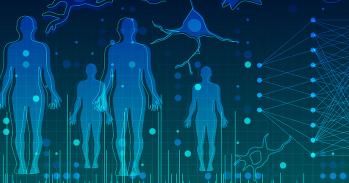
The discovery by scientists in Cambridge and Alberta of a fifth adaptor protein – a tiny and vital component of many cells –will lay the foundations for a greater understanding of genetic disorders.
The discovery by scientists in Cambridge and Alberta of a fifth adaptor protein – a tiny and vital component of many cells –will lay the foundations for a greater understanding of genetic disorders.
This fundamental research could impact on the study of diseases where certain molecules fail to get trafficked correctly.
Dr Jennifer Hirst
The people who work there call it the Titanic. The Cambridge Institute for Medical Research, a shiny building with funnel-like air vents on the Addenbrooke’s complex, is the workplace of around 250 scientists, many of them internationally acclaimed in their fields. Its 40 research groups are dedicated to advancing the basic and clinical science that is needed to understand the molecular mechanisms of disease. It is in these laboratories that some of the foundational research takes place that will pave the way for the development of drugs and therapies that will save lives in the future.
Earlier this year one of these groups – a team of seven scientists led by eminent cell biologist Professor Margaret Robinson – made a discovery that will lead to some of the key information contained in cell biology textbooks being revised. Working with colleagues at the University of Alberta in Canada, the team showed that the cells of all eukaryotes (a term used to describe the cell structure of animals, plants and fungi) contain five adaptor protein complexes (APs). This finding confounds existing assumptions that only four APs are present in cells – and will help scientists learn more about, and ultimately treat, certain genetic disorders.
Scientists have known about the existence of APs – which are vital to the functions of cells – ever since the late 1970s. Four APs were identified by researchers in the space of some 20 years. “As recently as 2004 I was quoted in the scientific literature stating categorically that there were no more than four APs,” says Professor Robinson. “It just goes to show that you can’t be too certain that you’ve found everything there is to find. And even more importantly it illustrates just how vital it is to carry out fundamental research, to provide the knowledge needed to feed into the translational research that could ultimately lead to cures for diseases.”
Cells are often described as the building blocks of life. As every school child is taught, cells have a nucleus, a surrounding membrane and cytoplasm. The intricate workings of the cell, however, are much more complex and represent a fascinating puzzle for biologists. Cells are full of compartments, visible only through the most powerful microscopes. These compartments do not exist in isolation but communicate with each other – for example, to send newly-made molecules from the place where they are manufactured to the place where they need to be in order to function.
Tiny spherical vesicles transport proteins and other molecules around the cell in a process that scientists call trafficking. But in order for the different compartments not to get mixed up, the cell needs to put some molecules into vesicles as cargo to be delivered to a new compartment, while leaving others behind. The machinery that selects which molecules will go into the vesicles includes the adaptor proteins. The word adaptor is used to describe their ability to connect two different types of molecules together: the cargo and the structural proteins that physically form the vesicle.
The way in which adaptor proteins pick up molecules from compartments can be likened to diners in a sushi bar, picking up dishes of food from a passing conveyor belt avoiding items they dislike and opting for those they desire. “APs have different ways of recognising molecules. It’s a process that we are only just beginning to understand, but this fundamental research could impact on the study of diseases where certain molecules fail to get trafficked correctly,” says Dr Jennifer Hirst, who is a senior researcher in the Robinson lab and has discovered and characterised a number of new adaptors.
The best characterised adaptors exist as complexes of four different proteins: two large, one medium, and one small. Two of these adaptor protein complexes – known as AP-1 and AP-2 – were the first ones to be identified, and they are essential to life. AP-3 was found in the mid-1990s and AP-4 in 1999. All four of these APs are found in most organisms – though it has been shown that some organisms naturally lack one of them, because they do not need it and so have lost it during evolution. People who lack AP-3 and AP-4 suffer from different conditions such as lack of skin pigmentation in the case of AP-3 and learning difficulties in the case of AP-4.
The discovery of a fifth AP came about when micro-biologists found a so-called ‘orphan’ protein in a soil amoeba, which bore a weak family resemblance to the medium-sized subunits of AP complexes, but did not seem to fit the profile of the other family members. What was the role of this orphan, which was found in humans and other vertebrates, but not in flies, worms and yeast?
In carrying out their research the Cambridge scientists developed a partnership with peers at the Department of Cell Biology at University of Alberta where Assistant Professor Dr Joel Dacks is an evolutionary cell biologist. His special interest is in the evolution and diversity of the eukaryotic membrane-trafficking system. “It was Joel who first alerted us to this orphan protein,” said Dr Robinson. “He sent us an email asking if we wanted to collaborate with him to investigate its function. He said: ‘Whatever it is doing, it has been doing it for a long time.’ This is because the strands of life that gave rise to humans on the one hand, and the soil amoebae on the other hand, separated from each other over a billion years ago. The fact that we both have this orphan protein means that it must have already existed in our common ancestor.”
In their search for an answer, Dr Hirst and colleagues carried out four years of meticulous research, much of it involving frustrating bench work in their lab on the fifth floor at CIMR looking for other proteins that might bind to the orphan. In spite of differences between the orphan and the medium-sized subunits of the four AP complexes, they eventually found that the orphan protein has a family after all. It gets together with two large proteins and a small protein to make a fifth AP complex. One of the large proteins had already been implicated in a genetic disorder, hereditary spastic paraplegia.
The identification of AP-5 may prove helpful in the understanding of conditions such as hereditary spastic paraplegia – though the scientists involved in its discovery stress that their research is at an early stage. “We are really excited to have found that there is a medical connection, but much further research will be needed to how loss of AP-5 leads to this particular disorder.”
This work is licensed under a Creative Commons Licence. If you use this content on your site please link back to this page.





